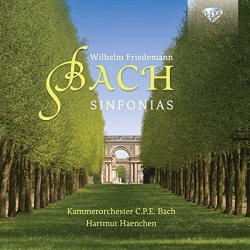|

|
Wilhelm Friedemann BACH (1710-1784)
Orchestral Works
Sinfonia in F Dissonant Fk 67 [11.19]
Sinfonia in F Fk88 from the cantata for Pentecost Sunday Erönt ihr seligen Völker [7.33]
Sinfonia in D minor Fk 65 [9.20]
Sinfonia in D major from the Pentecost Cantata Dies ist der Tag Fk 64 [9.24]
Sinfonia in D Fk 91 from the cantata for Ascension Day Wo geht die Lebensreise hin [3.17]
Sinfonia in G Fk 92 from the Cantata for Christmas O Wunder, wer kann dieses fassen [3.08]
Suite in G minor (BWV1070) [17.35]
Kammerorchester Carl Philipp Emmanuel Bach/Hartmut Haenchen
rec. May-June 1993, Jesus-Christus Church, Berlin-Dahlem, Germany
BRILLIANT CLASSICS 94690 [71.41]
Whilst listening to this CD from the ever-enterprising Brilliant Classics I found myself comparing it with a Capriccio disc by Tafelmusik, also from the mid-1990s. The latter shares five of these works: Sinfonia in F, Sinfonia in D minor, the D major one from the Pentecost Cantata Dies ist der Tag and the Suite in G minor.
I expected, for some reason, to find Tafelmusik the perfect ensemble for this repertoire, more crisp, authentic and modern. However, I was quite surprised at the ‘flabbiness’ of their tempi at times. This can be heard, for example, in the Adagio from the D minor Sinfonia; surely this is too sluggish. Also the Vivace of the D major Sinfonia lacks the very vitality and excitement which the Kammerorchester C.P.E. Bach manage to convey.
The Sinfonia in F Dissonant is so-called because of its extraordinary harmonies - particularly in the first movement. Significant characteristics of the piece include original fresh ideas, striking key changes and sudden dynamic alterations. C.P.E. Bach is not far away but it seems that W.F. was much less regarded and understood in Berlin than his brother in Hamburg. Anyway, this is a wonderful work but its finale , a pair of Minuets is short and unassuming and does not chime in with the rest of the work. Perhaps it isn’t really a part of the piece as W.F.’s manuscripts are in something of a confused state. The interesting booklet notes by Hartmut Haenchen, the conductor and architect behind this project, do not directly say this but he does remind us that W.F.’s “output was never actually published”. He goes on “and many of the works have been destroyed”. There could be nine symphonies but five are lost at present. I like this performance; it knocks over two minutes off that of Tafelmusik. This doesn’t matter in itself except that interest and a strong sense of involvement are well communicated. The style of this work is the language of ‘empfindsamer Stil’ – the demonstration of true and natural emotion developed more by mid-period Haydn and C.P.E. Bach – nervous volatility and mercurial mood changes.
In the case of the Sinfonia in D minor here we have a one movement piece which may well have formed the opening to a cantata but may also be part of a lost symphony. The trouble is that so much of W.F.’s work has vanished which means that what is left could be fitted onto just a couple of discs. This Sinfonia begins with a very moving Adagio which boasts some delicious, sequential flute writing before it segues into a somewhat severe fugue. It was here for the first time that I found the Chamber Orchestra C.P.E. Bach, who play on modern instruments, rather heavy and over-earnest. This is not a statement I would make about Tafelmusik who play either eighteenth century instruments or accurate modern copies. So “ya’ pays yer’ money and ya’ takes yer’ choice”.
The single movement Allegro which constitutes the Sinfonia in F also once formed part of another Pentecost cantata. It is elegant and quite delightful in its writing for the two oboes which wind there way around the wide-ranging string writing. It is also quite original and a little quirky. Even so this piece demonstrated another aspect of W.F.’s and of eighteenth century music in general being in a more ‘galant’ style. Similarly the brief Sinfonia in G, written for a Christmas Cantata, is suitably happy and elegant as is the equally short ceremonial Sinfonia in D for Ascension Day, which features brass instruments. So different are these pieces that it may be difficult to believe that the same hand is responsible for both.
Talking of which, the last work, the five movement Suite in G minor, has been credited to W.F.’s father and given as above, a BWV number. It’s rather eclectic and more in the style of the mid-eighteenth century. The fact that it has a movement (the second) entitled ‘Torneo’ and a final ‘Capriccio’ and has a first movement fugue not dissimilar to the one in the D minor Sinfonia, seems to indicate a place of origin that may even be Austrian. Here I mostly prefer Tafelmusik who on the Capriccio CD are particularly fleet of foot. The background to this piece is rather complicated and the booklet notes go into some fascinating detail.
This is a very useful overview of W.F. Bach and for some of you may complement a disc of his keyboard concertos. It's just worth finishing by saying that in that massive series of eight volumes ‘Man and Music’ - in the fifth one ‘The Classical Era’ - there is only one reference to W.F. in four hundred pages.
Will his time ever come?
Gary Higginson
 |
 |
|
